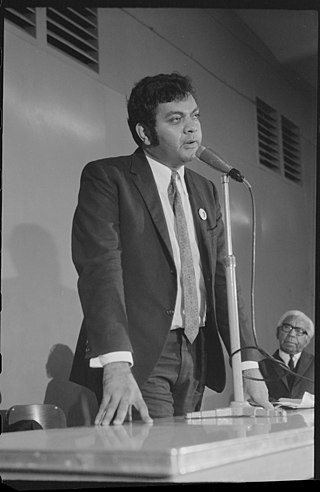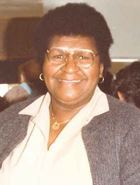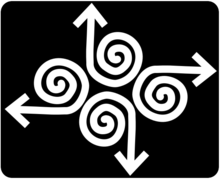
The second question of the 1967 Australian referendum of 27 May 1967, called by the Holt government, related to Indigenous Australians. Voters were asked whether to give the Commonwealth Parliament the power to make special laws for Indigenous Australians in states, and whether Indigenous Australians should be included in official population counts for constitutional purposes. The term "the Aboriginal Race" was used in the question.

John Newfong was an Aboriginal Australian journalist and writer. A descendant of the Ngugi people of Moreton Bay, he was the first Aboriginal person to be employed as a journalist in the mainstream print media in Australia.

Faith Bandler was an Australian civil rights activist of South Sea Islander and Scottish-Indian heritage. A campaigner for the rights of Indigenous Australians and South Sea Islanders, she was best known for her leadership in the campaign for the 1967 referendum on Aboriginal Australians.
Indigenous Australian self-determination, also known as Aboriginal Australian self-determination, is the power relating to self-governance by Aboriginal and Torres Strait Islander peoples in Australia. It is the right of Aboriginal and Torres Strait Islander peoples to determine their own political status and pursue their own economic, social and cultural interests. Self-determination asserts that Aboriginal and Torres Strait Islander peoples should direct and implement Aboriginal and Torres Strait Islander policy formulation and provision of services. Self-determination encompasses both Aboriginal land rights and self-governance, and may also be supported by a treaty between a government and an Indigenous group in Australia.
The voting rights of Indigenous Australians became an issue from the mid-19th century, when responsible government was being granted to Britain's Australian colonies, and suffrage qualifications were being debated. The resolution of universal rights progressed into the mid-20th century.
Charles Duguid was a Scottish-born medical practitioner, social reformer, Presbyterian lay leader and Aboriginal rights campaigner who lived in Adelaide, South Australia for most of his adult life, and recorded his experience working among the Aboriginal Australians in a number of books. He founded the Ernabella mission station in the far north of South Australia. The Pitjantjatjara people gave him the honorific Tjilpi, meaning "respected old man". He and his wife Phyllis Duguid, also an Aboriginal rights campaigner as well as women's rights activist, led much of the work on improving the lives of Aboriginal people in South Australia in the mid-twentieth century.
The Aboriginal Advancement League was founded in 1957 as the Victorian Aborigines Advancement League (VAAL), is the oldest Aboriginal rights organisation in Australia still in operation. Its precursor organisations were the Australian Aborigines League and Save the Aborigines Committee, and it was also formerly known as Aborigines Advancement League (Victoria), and just Aborigines Advancement League.

Mick Miller was a notable Aboriginal Australian activist, politician, and statesman who campaigned for most of his life seeking greater social justice, land rights, and improved life opportunities for Aboriginal Australians in North Queensland and the rest of Australia.
Commonwealth, State, and Territory Parliaments of Australia have passed Aboriginal land rights legislation.
Indigenous land rights in Australia, also known as Aboriginal land rights in Australia, are the rights and interests in land of Aboriginal and Torres Strait Islander people in Australia; the term may also include the struggle for those rights. Connection to the land and waters is vital in Australian Aboriginal culture and to that of Torres Strait Islander people, and there has been a long battle to gain legal and moral recognition of ownership of the lands and waters occupied by the many peoples prior to colonisation of Australia starting in 1788, and the annexation of the Torres Strait Islands by the colony of Queensland in the 1870s.

Daisy Elizabeth Marchisotti was an Australian social and political activist whose commitment to Indigenous rights saw her remain an active member of the political community up until her death in 1987. She is known for her communist affiliations and was an active member of the Communist Party of Australia.
The One People of Australia League was an Australian Aboriginal political grouping in the 1960s and the 1970s. In contrast to the more radical and left-wing bodies advocating for indigenous sovereignty at the time, OPAL was for most of its existence overtly assimilationist, advocating for the integration of Aboriginal Australians into mainstream white culture. Its main focus was on welfare and housing and as it received monies from the Queensland government for its programs, the work of OPAL had both equal parts support and criticism for not being independent and operated by non-Indigenous organisers.
Margaret Wirrpanda was a campaigner for Australian Aboriginal rights.
Evelyn Ruth Scott was an Indigenous Australian social activist and educator.

Eleanor Harding was an Indigenous Australian from the Torres Strait Islands who worked to attain civil rights for Aboriginal Australians. She advocated for women's rights and adequate educational opportunities, as well, serving with numerous organizations to attain equality for indigenous people. In 2012, she was inducted into the Victorian Aboriginal Honour Roll by the State of Victoria.
Joseph Daniel McGinness (1914–2003), known as "Uncle Joe'", was an Aboriginal Australian activist and the first Aboriginal president of the Federal Council for the Advancement of Aborigines and Torres Strait Islanders (FCAATSI).
The Council for Aboriginal Rights (CAR) was founded in Melbourne in 1951 in order to improve rights for Indigenous Australians. Although based in the state of Victoria, it was a national organisation and its influence was felt throughout Australia; it was regarded as one of the most important Indigenous rights organisations of the 1950s. It supported causes in several other states, notably Western Australia and Queensland, and the Northern Territory. Some of its members went on to be important figures in other Indigenous rights organisations.
The Aboriginal-Australian Fellowship (AAF) was a Sydney-based organisation focused on changing the New South Wales Aborigines Protection Board, the wider issues of wage parity and full citizenship for Aboriginal Australians.
The Aborigines and Torres Strait Islanders Advancement League, (CATSIAL), also referred to as the Cairns Aborigines and Torres Strait Islanders Advancement League or Cairns Aboriginal and Torres Strait Islander Advancement League, and Aborigines and Torres Strait Islanders Advancement League (Cairns), was an Indigenous rights organisation founded in Cairns, Queensland in January 1960. It existed until the late 1970s.
Albert Barrie Pittock is an Australian climatologist, environment scientist, author, and advocate for the rights of Indigenous Australians. He was among the many recipients of the 2007 Nobel Peace Prize.







